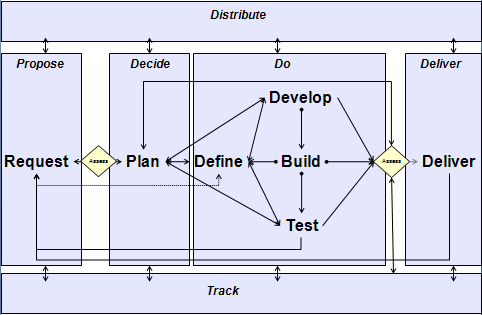This wiki is locked. Future workgroup activity and specification development must take place at our new wiki. For more information, see this blog post about the new governance model and this post about changes to the website.
Collaborative ALM Scenarios
This page is the launching point for exploring the OSLC resources through scenarios. Relationships between resources are defined through scenarios. The pattern below serves as a guide for the inventory of scenarios. By tracing the arrows, important relationships are understood. The pattern purposefully removes process & role definition. The key is to focus on the relationships.- A pattern for understanding CALM scenarios:

Propose
Moving from 'proposal' to plan. Requests come in, are triaged and decided upon.Decide
Moving from Deciding to Doing. Requests brought into a plan are sized and decomposed into work-items for the team members. Align Plans - this scenario involves deciding on 'what' (requirements) and 'when' (plan). It includes aligning requirements with the development and test plans.Do
Doing. Defect test execution reveals defectDeliver
Moving from Doing to Delivering. Determining completion & delivering the result of the iteration/project. Assess Completeness - How do you know you're done? Deliver - Deliver the completed iteration/project Defect End user submits defect against production system Asset Management Scenarios - delivering a release includes creating assets which may be used in the next delivery cycle Status Tracking - scenarios specific to tracking status (which are not included above) Status Tracking - scenarios specific to tracking status (which are not included above)Distribute
Previously developed workproducts (assets) are used and created throughout the lifecycle, from Propose, to Decide, to Do and to Deliver. Asset Management Scenarios - scenarios specific to managed Assets which are included in horizontal bar 'Distribute' -- CarolynPampino - 21 Jan 2009Mylyn Scenarios - Draft in progress
| I | Attachment | Action | Size | Date | Who | Comment |
|---|---|---|---|---|---|---|
| |
CALM_Pattern_map.gif | manage | 11.5 K | 16 Jan 2009 - 21:22 | CarolynPampino | A pattern for understanding CALM scenarios |
Topic revision: r8 - 11 Jun 2009 - 20:15:33 - GrantLarsen
Main.CalmHome moved from Main.CALMHome on 11 Feb 2009 - 18:47 by ScottBosworth - put it back
Contributions are governed by our Terms of Use
Ideas, requests, problems regarding this site? Send feedback

